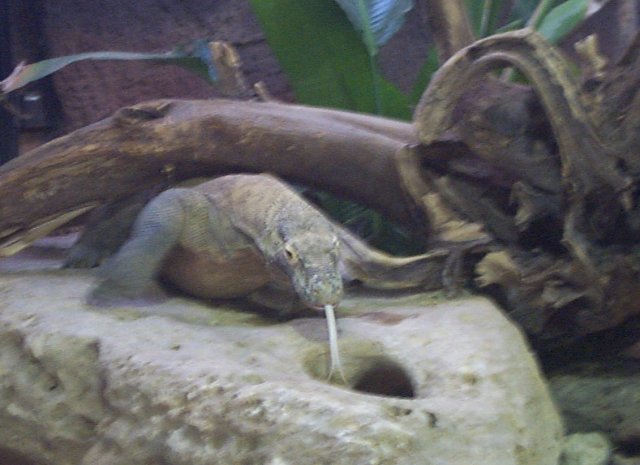

Name:
Komodo Monitor (Komodo Dragon)Scientific Name:
Varanus komodoensisRange:
Komodo Dragons are found exclusively on the islands of Komodo, Rinca, Padar, Flores, and the Sunda IslandsHabitat:
Warm climates; desert and tropical regionsStatus:
ProtectedDiet in the Wild:
Young monitors feed on insects, small lizards, and the nestlings of small mammals; larger monitor species seek larger prey, such as fish, birds, frogs, rats, and snakes; the Komodo Dragon can even take small deer and wild pigs.Diet in the Zoo:
Carnivore diet.Location in the Zoo:
KomodoDragon Exhibit
Physical Description:
The Komodo Dragon is the largest and heaviest of the monitor lizards, reaching lengths up to 3 meters (about 9 ft). Average weight of wild animals is 70 kg, although captive animals can get heavier. The tail is as long as the body. They have jagged teeth that are 1cm long.General Information:
There are roughly 30 different species of monitors. They are all characterized by a long, forked, snakelike tongue. The Komodo Dragon is the largest living lizard in the world today.Komodo Dragons are extremely territorial animals. The males fight over the right to mate with a particular female. They "stand" on their hind legs and wrestle each other to the ground. The one who gets pinned down loses. The winner then rakes his claws in slow, long strokes down the length of the losers body.
Komodos lay eggs, and the female will protect her nest during the incubation period. However, once hatched, the little dragons are on their own If they survive their vulnerable juvenile period, komodos may live for over 30 years.
Special Anatomical, Physiological, or Behavioral Adaptations:
Like snakes, monitors can use their forked tongues to follow scent trails. Komodo dragons are mostly ambush predators, although they can run at 20 mph. In their natural habitat they are at the top of the food chain and can take down prey as large as a water buffalo. Both their jaws and their stomachs are expandable, and komodos can consume as much as 80% of their body weight at one time. Their bite is deadly, because their saliva contains many species of bacteria, which leads to rapid infection in any animal that doesn't immediately bleed to death. Interestingly, although they may also bite one another, they seem to be immune to infection by their own bacteria. Scientists are very interested in the komodo's immune defenses.
Monitor lizards also have an interesting adaptation for breathing. Many lizards cannot run and breathe effectively at the same time because the rib muscles used for breathing are also used for running. However, monitors have a pouch under their chins called a gular pouch. Monitors fill the pouch with air and then pump air down into their lungs.
Comments about the Komodo Dragon of the Fort Worth Zoo:
Currently, there are two Komodo Dragons at the Fort Worth Zoo.
More pictures of the Fort Worth Zoo's Komodo Dragon.Personal Observations:
Since Komodo Dragons are cold blooded animals, they preserve theirenergy in order to maintain body temperature, so they aren't particularlyactive. I did notice that the Komodo Dragon was quite well hidden amonghis exhibit. It is very much like his natural habitat.Sources:
Encarta Encylcopedia. 1997.Ciofi, C. The Komodo Dragon. Scientific American, March 1999.
http://www.sciam.com/article.cfm?articleID=000EFE16-865C-1CD6-B4A8809EC588EEDFWinters, C. Komodo Monitor. University of Michigan Animal Diversity Web Site.
http://animaldiversity.ummz.umich.edu/accounts/varanus/v._komodoensis$narrative.htmlBlanchard. D. How Do Lizards Breathe? Cold Blooded News, July 1999.
Of Dragons and Doctors. Pulse, Winter 2000.
Links:
WhoZooHome |
Questions or Comments
E-mail Amanda